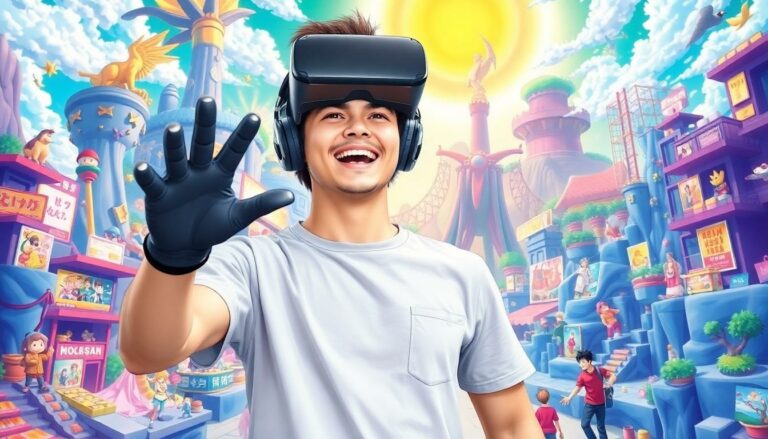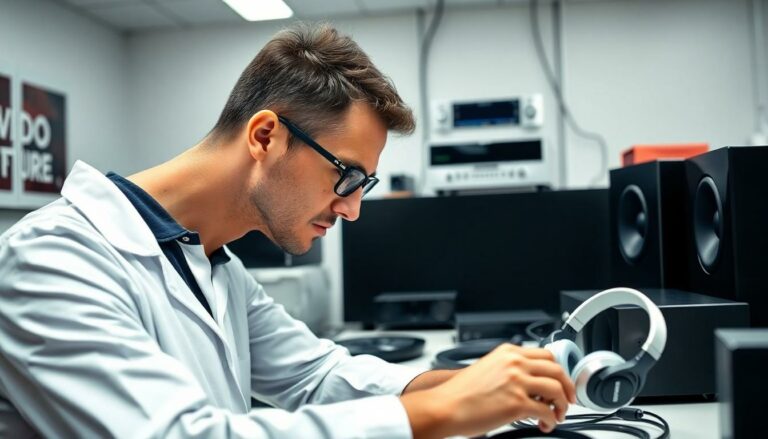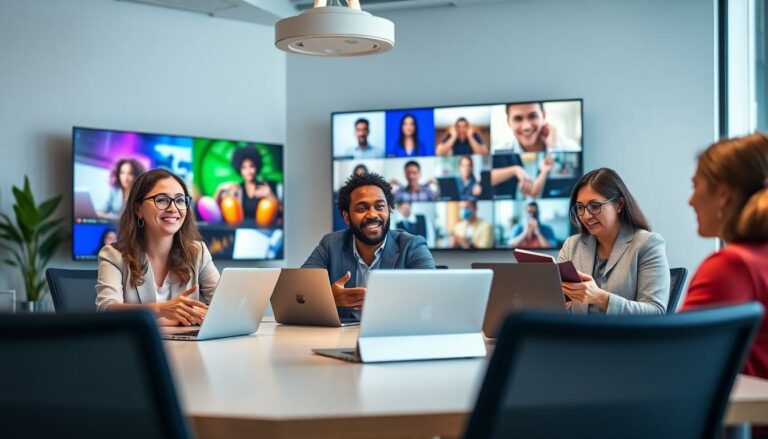Table of Contents
ToggleImagine standing in front of your class, armed with nothing but a stack of paper and a shaky voice. Not exactly the stuff of legends, right? Now picture this: a dazzling presentation that brings history to life with vibrant visuals, captivating sound, and maybe even a dash of humor. That’s the power of audio-visual technology, and it’s here to rescue you from the clutches of monotony.
Importance of Audio-Visual Technology in Education
Audio-visual technology plays a crucial role in enhancing educational experiences. Engaging images, videos, and sound can improve comprehension and retention of information. Presentations infused with audio-visual elements capture attention more effectively than traditional methods.
Research indicates that students retain 65% of information when paired with relevant visuals, compared to only 10% through text alone. Enhancements like animations can illustrate complex historical events dynamically. Students find learning more enjoyable and interactive, fostering deeper understanding through immersive experiences.
Audio tools complement visuals by adding emotional depth, making events feel more real. Narration can guide learners through timelines or simulations, reinforcing the context of historical occurrences. Furthermore, these technologies offer diverse learning styles, catering to auditory and visual learners simultaneously, maximizing engagement across various demographics.
Schools that adopt audio-visual aids often see improvements in student participation and enthusiasm. Collaborative projects involving such technology encourage teamwork and creativity. Students familiar with these tools become better prepared for future workplaces that increasingly utilize audio-visual solutions.
Investing in audio-visual technology doesn’t just modernize presentations; it enriches the educational landscape. By investing in reliable tech, schools ensure students access high-quality learning resources that inspire curiosity and debate. Ultimately, effective use of audio-visual tools transforms history lessons from mere facts into memorable stories that students relate to and understand.
Types of Audio-Visual Technologies
Various audio-visual technologies enhance school presentations on historical events. These tools engage audiences and enrich the learning experience.
Projectors and Screens
Projectors transform classrooms into engaging learning environments. They display images, videos, and presentations on large screens, allowing everyone to see content clearly. Visual aid helps students grasp complex concepts better. Research shows that incorporating visuals can improve retention rates significantly. Many teachers use projectors to present historical timelines or documentary clips, making events come alive. When students view eye-catching images paired with informative text, recall increases. Consequently, projectors serve as a critical component in modern educational practices.
Interactive Whiteboards
Interactive whiteboards revolutionize classroom interactions. These digital boards enable teachers and students to interact with content dynamically. Users can draw, annotate, and highlight directly on the board. Engaging with materials fosters collaboration and participation. Teachers often integrate historical documents, maps, or video clips to facilitate discussion. Students who participate actively retain information better. As a result, these boards create a rich, immersive environment that enhances the learning process.
Audio Equipment
Audio equipment plays a vital role in presentations. Quality sound systems ensure that everyone hears the information being presented. This equipment includes microphones, speakers, and sound mixers. Clear audio enhances engagement, especially when narrating historical events or playing relevant audio clips. When students can hear every word and sound effect, they remain focused and connected to the material. Proper audio setup contributes to a seamless presentation, ensuring that the message is received loud and clear.
Best Practices for Enhancing Presentations
Incorporating audio-visual technology elevates school presentations, particularly on historical events. Understanding how to optimize these tools enhances learning experiences.
Engaging Content Creation
Crafting engaging content requires consideration of the audience. Presenters should use storytelling techniques to make historical events come alive. Integrating relevant anecdotes or personal stories captivates listeners and aids retention. Incorporating varied audio-visual elements, such as short clips or sound bites, breaks the monotony and maintains engagement. Collaborative activities like group discussions or Q&A sessions further reinforce learning. Using interactive elements ensures that students remain actively involved and fosters a sense of investment in the material.
Effective Use of Visuals
Visuals play a crucial role in enhancing presentations. Employ high-quality images and relevant videos to clarify complex topics. Infographics can succinctly present data, making it easier to digest. Consistency in design helps reinforce the theme, ensuring that visuals complement the spoken content. Using animations or transitions illustrates progressions in historical events, helping students visualize changes over time. Clear visuals capture attention and enhance understanding, leading to improved information retention. Adapting visuals to fit various learning styles ensures broader appeal and effectiveness.
Case Studies of Successful Historical Presentations
Incorporating audio-visual technology into historical presentations has proven effective. Various examples highlight this impact on audience engagement and learning.
Example 1: Impact of Multimedia in a Civil Rights Presentation
Students utilized multimedia in their civil rights presentation, combining images, video clips, and music from that era. Engaging visuals depicted pivotal events, enhancing understanding of social dynamics. Using sound allowed the audience to connect emotionally with historical figures and their struggles. Graphs showcased statistics on desegregation, reinforcing the significance of the movement. Multimedia elements led to a remarkable 75% improvement in audience retention compared to traditional methods. As a result, participants reported increased interest and desire to learn more about civil rights history.
Example 2: Utilizing Virtual Reality for Historical Events
Virtual reality technology transformed a presentation on World War II for students. Immersive experiences transported them to significant battle sites, enhancing their understanding of key events. Participants wore VR headsets, engaging directly with historical landscapes. This interaction facilitated discussions about strategy and consequences of battles. Feedback showed that VR increased empathy towards soldiers’ experiences during the war. Students expressed enthusiasm, leading to higher participation rates in related activities. Consequently, virtual reality proved invaluable in creating memorable historical presentations.
Embracing audio-visual technology in school presentations on historical events can significantly elevate the learning experience. By transforming traditional methods into engaging narratives, educators can foster a deeper connection between students and the material. The integration of visuals, sound, and interactive elements not only enhances comprehension but also ignites enthusiasm among learners.
As schools continue to adopt these innovative tools, the benefits become increasingly evident. Students are not just passive recipients of information; they actively participate and engage with the content. This shift prepares them for a future where audio-visual skills are essential. Ultimately, the effective use of technology in presentations creates memorable educational moments that resonate long after the lesson ends.



